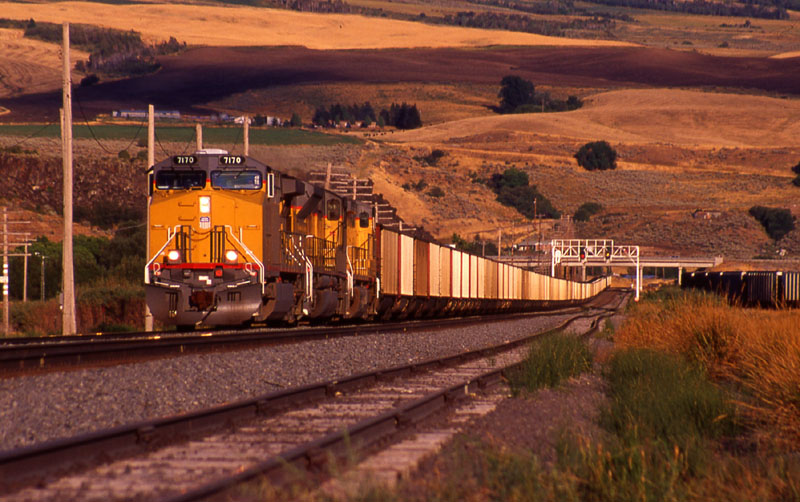
A Journey by Train
Photographing Railroads and their Environs by Jim Springer
Why photograph trains? It is an acquired taste, and most Train/Railroad photographers are what are known as “Railfans” - Trains (full size and often models) are their passion. And, to them (us), the passion is easily explained. What other man-made object can be over a mile long, weigh upwards of 10,000 tons, move at highway speeds, all while traversing every environment, from the most urban to the most rural, and from the most mundane to the most beautiful. Add the drama of standing trackside on a mountain grade while 6 locomotives exert 18,000 Horsepower to lift 10,000 tons of coal up and over the mountain. The ground shakes, your ears ring from the deafening throb of the diesel engines, the acrid smell of the exhaust fills your nostrils, and, you observe (and perhaps feel!) the enormous amount of waste heat emitted from the engines. Railroading can be a glorious spectacle, and capturing its essence on film (or flash memory!) can be very rewarding.
Why do I photograph trains? I grew up in a railroad family and lived in a railroad town. Both Grandfathers worked for the Pennsylvania RR, as did my Father, who also worked for Penn Central and Conrail. I grew up with trains, but never really became interested in them as photographic subjects until the early 1980’s. Since then, learning how to photograph them has been a continuing education, and I learn something new and try something different every time I go out on a photo quest.
All of the basic requirements of photography apply when photographing trains - proper lighting, exposure, sharp focus, and merger avoidance (if possible - they have a way of only being noticed only after you get your film back!). All these are givens. If any of these are absent, your chances of creating a good photo are about nil. What follows next is (1) following basic rules of composition, and (2) deciding what story you want your photograph to tell.
My photographic philosophy in a nutshell is to show trains in their environment, and attempt to show a sense of place, season, purpose, drama, the Who, What , When, Where, and Why. You probably can’t capture all 5, but you need to have at least a couple of these. I don’t like extreme close-ups of a train bearing down on you without showing any context. Yes, I have plenty of shots like this too, but they aren’t very satisfying. How many photographs can you take that accomplishes all these things and exhibits pleasing composition? If I get one out of 50, I’m happy. The best photographers only show their best stuff, and keep the rest private. Given all this, I would like to take you through some of my favorite shots and describe what was in my mind when I shot them.
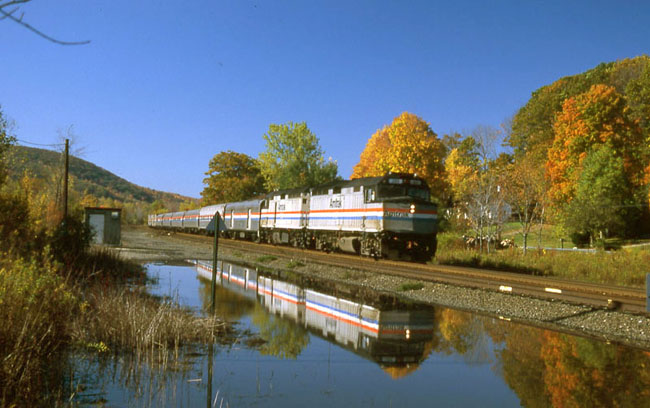
IMAGE 1: AMTRAK’s Lake Shore Limited heads for Boston at NY-MASS border on 10/13/95
In this shot, I attempted to show the train with the trees in fall color while taking advantage of a rain puddle. The light was not ideal (at a slightly oblique angle) but it still worked well. This is one time where it wasn’t necessary to go hunting for a place to shoot - this is at a grade crossing.
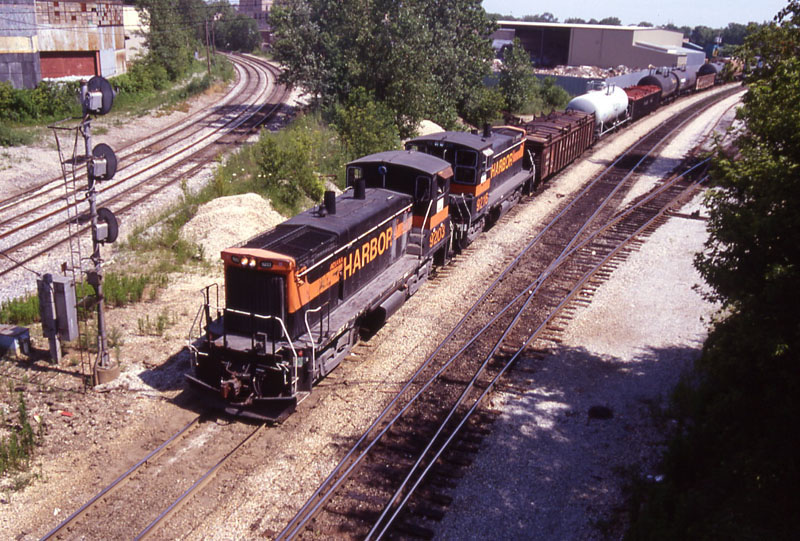
IMAGE 2: Indiana Harbor Belt #9202 & 9216 at Blue Island, IL.
This photo exhibits many features that enhance visual impact - the
use of the Golden Sections (See below).
The box is representative of a photograph, divided into 9 sub-sections.
Better photographs will show the subject at a place where the section
borderlines intersect. Items of lower interest, but still supportive
of the whole should populate the other sub-sections. I’m sure
all of you reading this have seen some version of this. Keep this in
mind when viewing all the following photos.
7 8 9
4 5 6
1 2 3
The subject (the train) stretches from Square 2 to Square 9. Other tracks
curve off from Square 4 to Square 8. A signal mast is another point
of interest in Squares 1 & 4. And other squares are filled either
by buildings or trees. The patterns created flow smoothly to each section
of the picture. In every picture I take, I try to position something
of interest at these “Golden intersections”. Another technique
featured in this photo, is that, when it is close to noon (the sun is
high), shooting down can still create good photos.
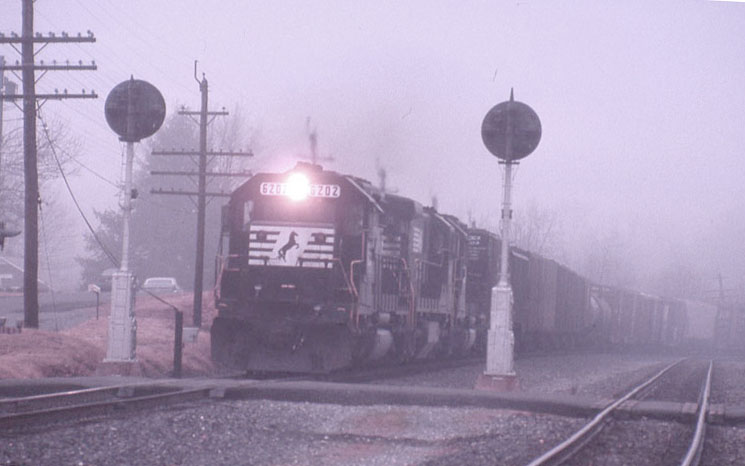
IMAGE 3: Eastbound Norfolk Southern Freight at Appomattox, VA. January
7, 1989.
Sometimes lousy weather can still yield good images. The Signal Masts frame the front of the train. The fog sets a somber mood.

IMAGE #4: Eastbound Norfolk Southern freight West of Chattanooga, August 9, 1994.
This shot, on a very hot and humid summer day, features the tracks extending back and curving gently, drawing your eye into the photo. The train also curves gently into the scene, framed by trees and the background gray hills.
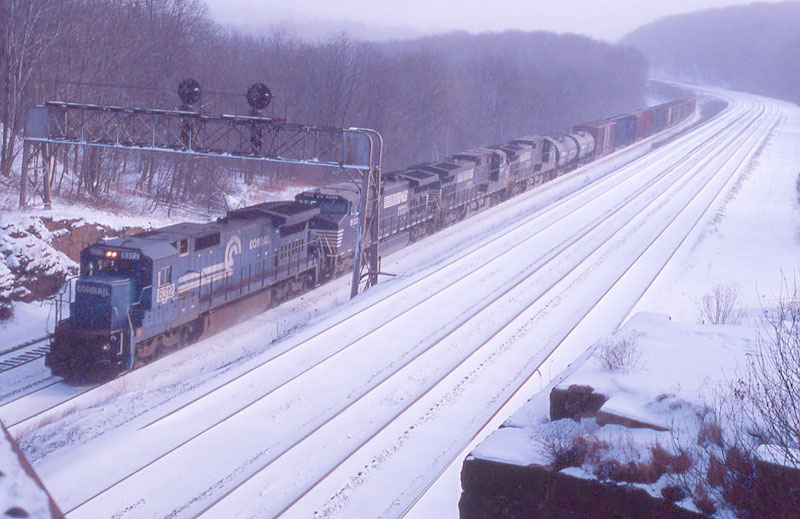
IMAGE 5: Westbound Norfolk Southern freight at Cresson, PA.. December 20, 2001
A bitterly cold and windy morning was braved for this photo. Again, the flowing curves across the photo, main subject at “Golden Intersection”, framed partially by a signal mast. BRRRR!!
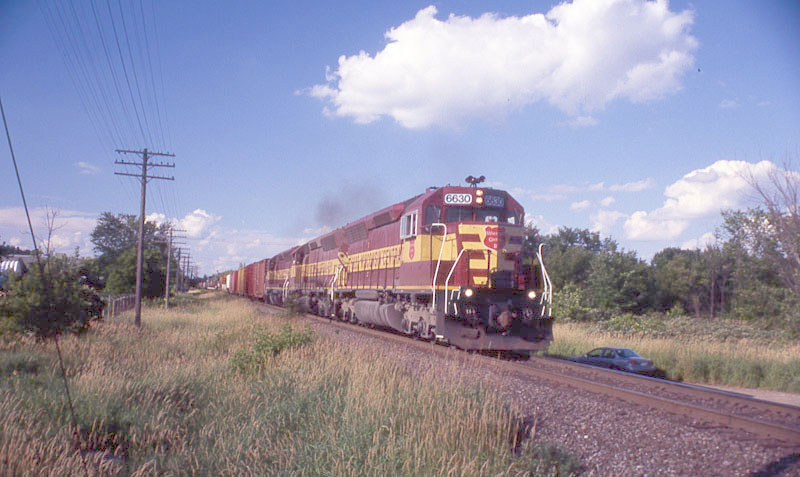
IMAGE 6: Southbound Wisconsin Central freight at Duplainville, WI.
Classic ¾ wedge shot, with nice blue sky and puffy white clouds, with the train counterbalanced slightly by telephone pole and wires along left side.
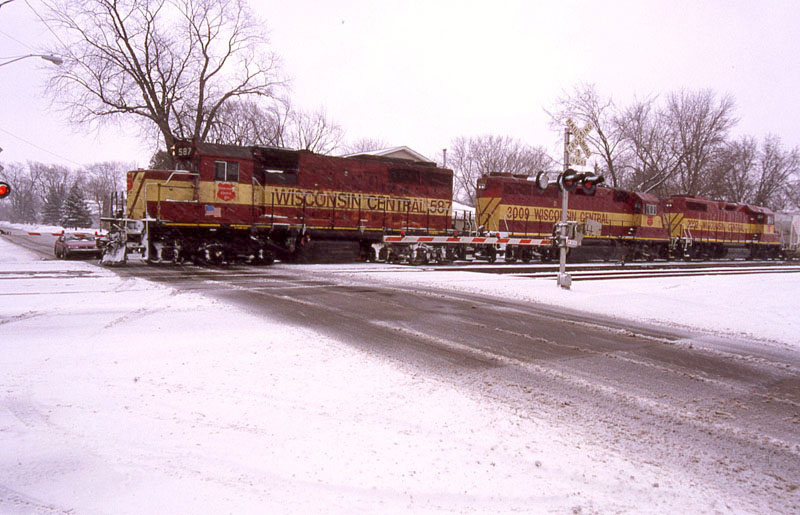
IMAGE 7: Wisconsin Central Manitowoc bound freight at Neenah, WI, 2/10/00.
I was driving along unfamiliar city streets to try to get a shot of this train departing the yard at Neenah, WI. I try to avoid grade crossings if possible, but this was my last chance for a picture, so I set up at the grade crossing. To add interest, I shot the train passing behind the crossing gates.
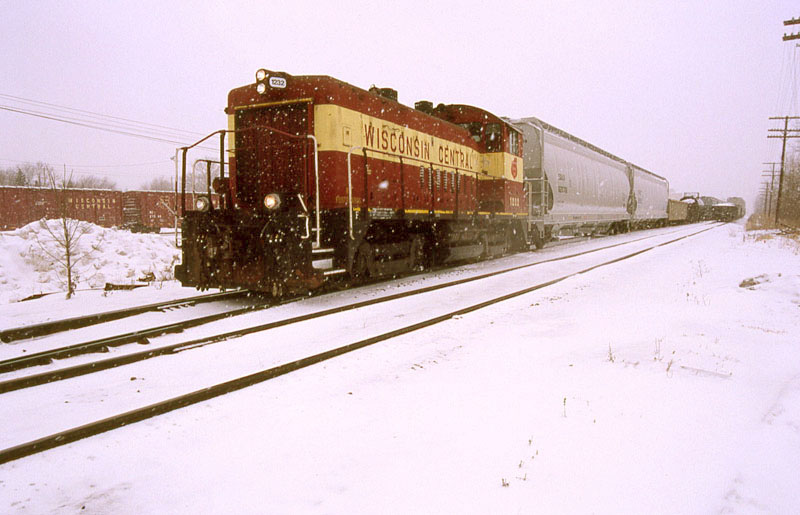
IMAGE 8: Wisconsin Central Switcher at Neenah, WI yard, 2/10/00
This shot had nothing surrounding it to effectively incorporate into the picture, so I attempted to create some drama by getting down on my knees in the snow and making the locomotive appear more predominant.
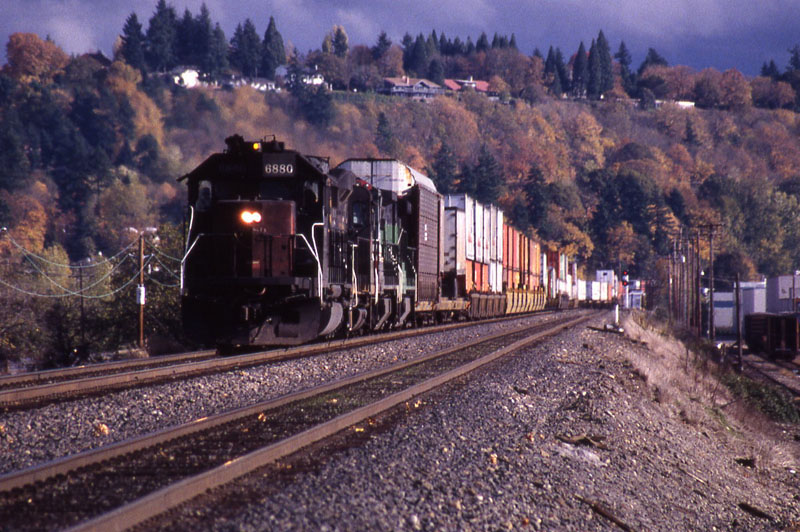
IMAGE #9: A Westbound Burlington Northern freight led by SSP 6880 at Vancouver, WA.
This image has a lot of drama. It is a telephoto shot (250 or 300 mm), bringing in close the houses and trees on the background hillside (I wish I lived there!). The sky is a dramatic cloudy gray, yet the sun is illuminating the side of the train and the landscape. A Train in the environment at it’s best!
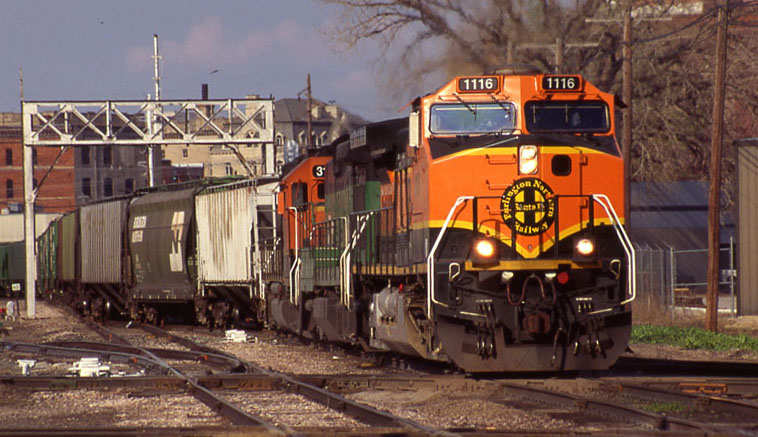
IMAGE #10: A Westbound BNSF Freight at Lincoln, NE, April 21, 1998.
This crowded urban scene shows the train predominantly, yet railroad infrastructure (track, signals, etc. are highly evident, as well as background buildings. As before, note placement of the elements and how they combine for drama and pleasing composition.
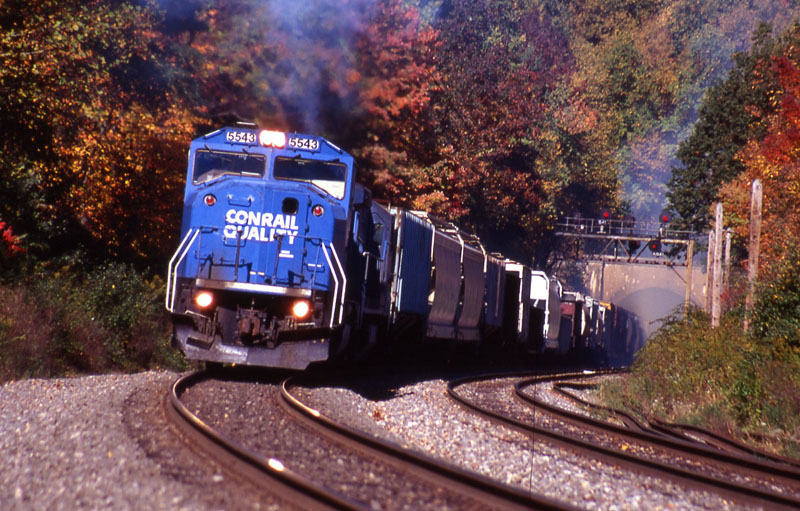
IMAGE #11: An Eastbound Conrail freight exits Pattenburg Tunnel, NJ, on October 11, 1997.
This is a long telephoto shot (300 mm) from some distance away, so that I could show the long grade coming out of the tunnel, as well as the background autumn trees. The drama shows in the smoke coming out of the tunnel and above the engine, showing the struggle to lift the train up the hill.
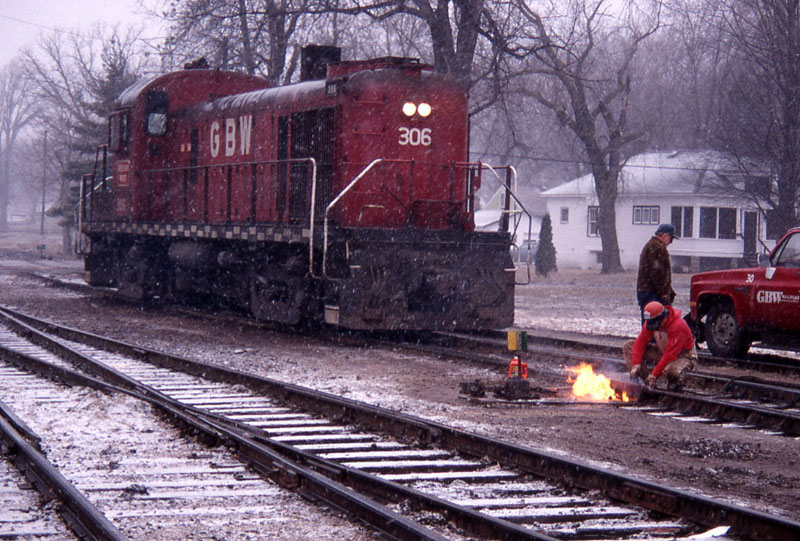
IMAGE #12: Green Bay & Western ALCO #306 at Norwood yard in Green
Bay, WI, 3/30/93
This is probably my favorite railroad shot of all time, and pure luck had a lot to do with it. It is unique because only 2 colors make up the bulk of the picture: Red and White/Gray, with a little yellow for the fire. The mood of the falling snow, and the worker thawing a switch so that the patiently waiting engine can get back to work, tells a timeless story.

IMAGE #13: Black River & Western freight at Phillipsburg, NJ, 4/18/96
Like all railroad photographers, I like the world of long, fast freights pulled by big lashups of roaring diesels. However, there is another side of railroading, that of the shortline providing vital service with a lone, often vintage locomotive and hauling a few cars. The Black River & Western, in Western NJ, is one such shortline. I like this shot because it was taken before the trees had sprouted leaves, and the background of all those barren branches, with the warm sunlight (albeit backlit) made a wonderful stage for the action, as slow paced as it obviously was
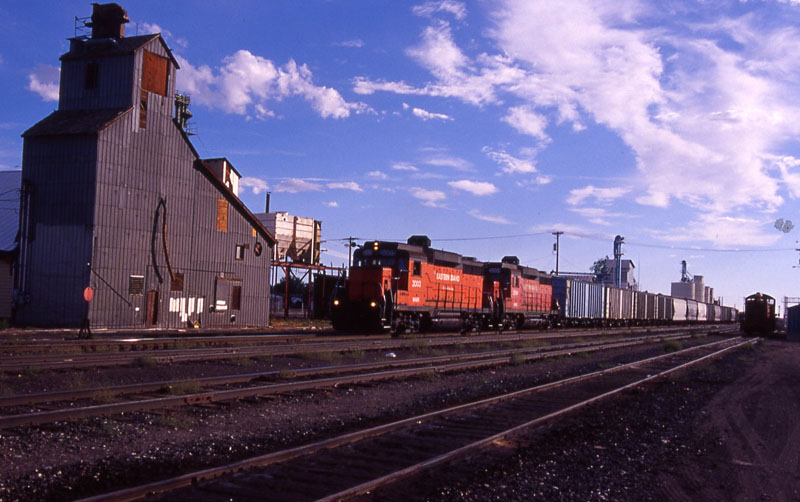
IMAGE #14: Eastern Idaho RR train at Rupert, ID, 8/10/99.
In this photo, I broke what I consider to be a cardinal rule of photography, but for good reason. The Rule: Never put your main subject in the middle of the frame. However, rules are meant to be broken, and this one was in order to balance the train on the right with that wonderful, old agricultural building (a grain elevator?) on the left. I chose this spot specifically to include it, and the rest of the photo speaks for itself - The wonderful dawn sky and the perfect lighting accentuating the textures of the building with thin, crisp shadows. This is one of my favorite shots.
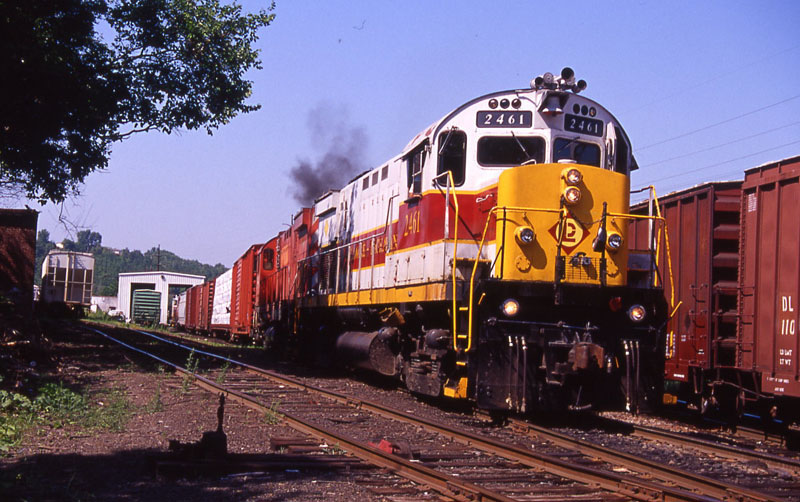
IMAGE #15: Delaware Lackawanna #2461 switching cars at Scranton, PA. 6/16/00
This is another shortline, of great interest because it uses vintage locomotives made by a company that went of out business in 1968. The company was American Locomotive Co, or ALCO. This photo is two of their vintage ALCO locomotives. To create a balanced scene and to evoke a sense of power and massiveness, I got down on my knees and shot at a slight upward angle to include the limbs of the overhanging tree on the left side and to make the locomotive appear to loom over the scene.

IMAGE #16: Chesapeake & Ohio #614 Steam locomotive at Port Jervis, NY: 10/26/96
In October of 1996, several weekends saw this locomotive running excursions from Hoboken, NJ to Port Jervis, NY and return. This photo was taken amid a sea of other photographers, as the excursion train is about to head back East to Hoboken. As with many other photos, I tried to balance elements within the picture - the signal mast to the left, the white equipment building on the right, the background buildings, and of course, the beautiful fall foliage above and behind the train.

IMAGE #17: Durango & Silverton at Durango, CO June 8, 1995.
The placement of the train and myself were totally fixed by circumstance in the photo. It was parked, awaiting loading of passengers in Durango. I shot at wide angle to encompass as much of the train as possible, while excluding some elements I didn’t want to show (as I recall, there was a set of golden arches behind the locomotive!).
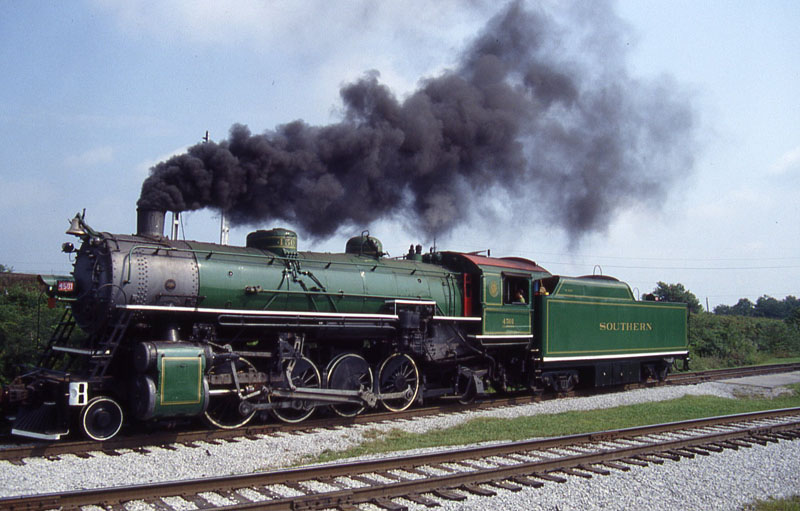
IMAGE #18: Southern #4501 Steam Locomotive at Tennessee Railroad Museum,
Chattanooga, TN, 9/10/92
As in all photographs, luck had a very important role in this one. This is a classic photo of a steam locomotive, driving rods down, side view. I visited the museum, which was closed when I got there, to kill some time before my flight back home. As luck would have it, this steam locomotive was being put through its paces as a test for an upcoming excursion that weekend. I was the only person there to photograph it as it was driven back and forth over the museum trackage. Under typical circumstances, you would have to shoehorn yourself into a line of photographers and probably photograph some of them as well. It was an experience I’ll never forget.

Image #19: Brand New UTLX Tankcars in a CONRAIL freight at Conway, PA. 6/27/97
I am like many or most photographers in that I look for pleasing patterns, and this photo shows that even in a train, when you least expect it, a neat bit of eye-catching symmetry can pop up. In this case, the subject is it’s own reason for being photographed - surroundings mean little in a photo like this.
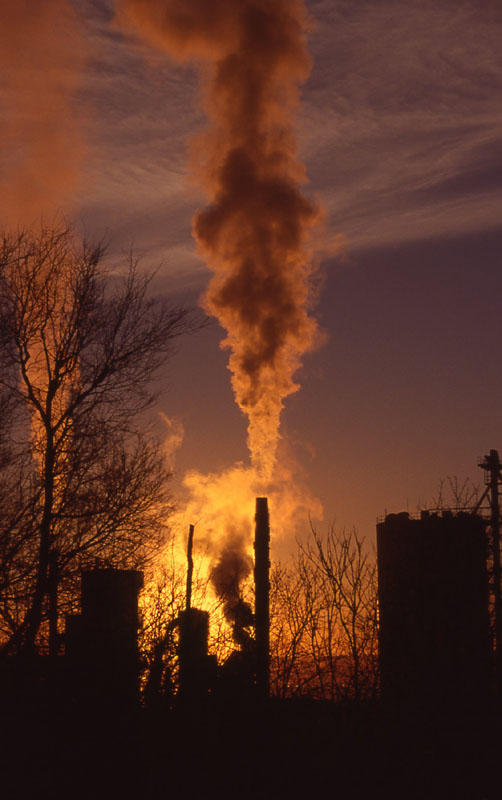
Image #20: - Soybean processing plant in Sioux City, Iowa - December, 1998.
This last photo just proves that you need to be aware of photographic opportunities, even if it is not your main interest. I was driving to work after railfanning in the early morning, and as I was driving, saw this stunning scene! I couldn’t stop the car fast enough, and leapt out and shot several slides.. This one, the best, was a 1 or 2 stop under-exposure.